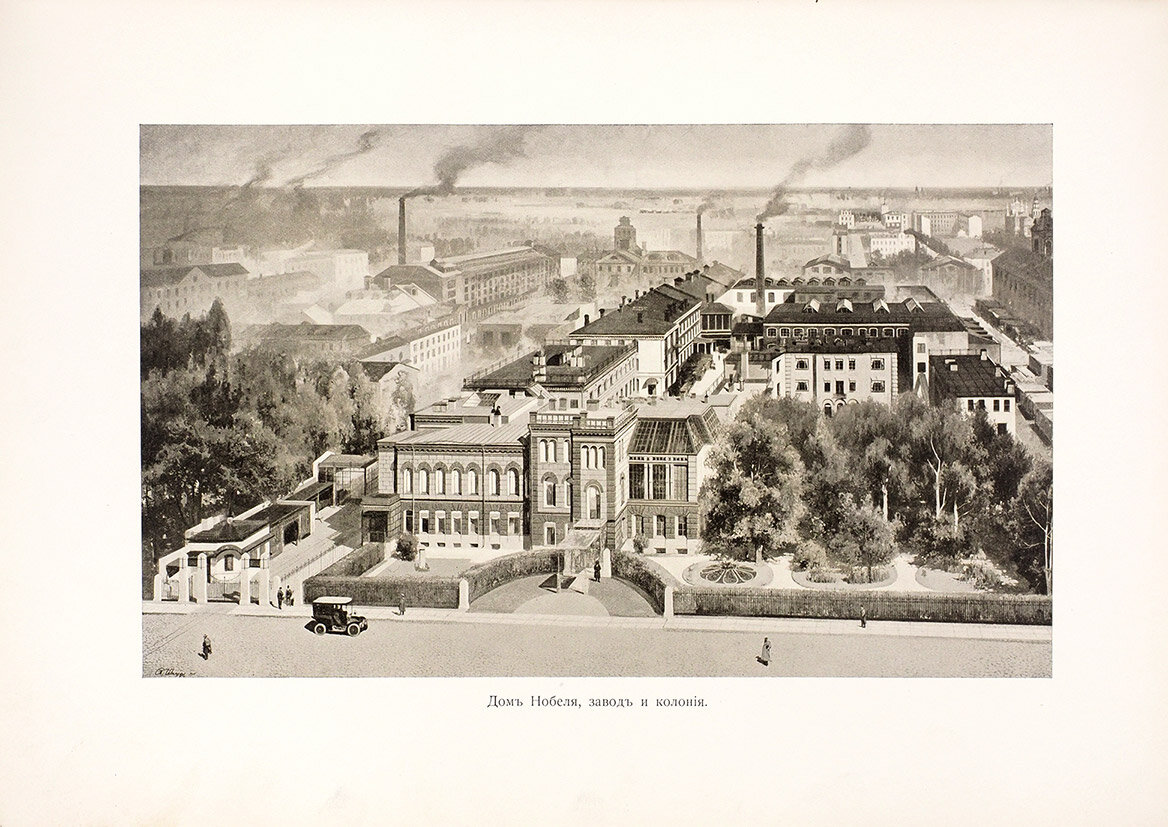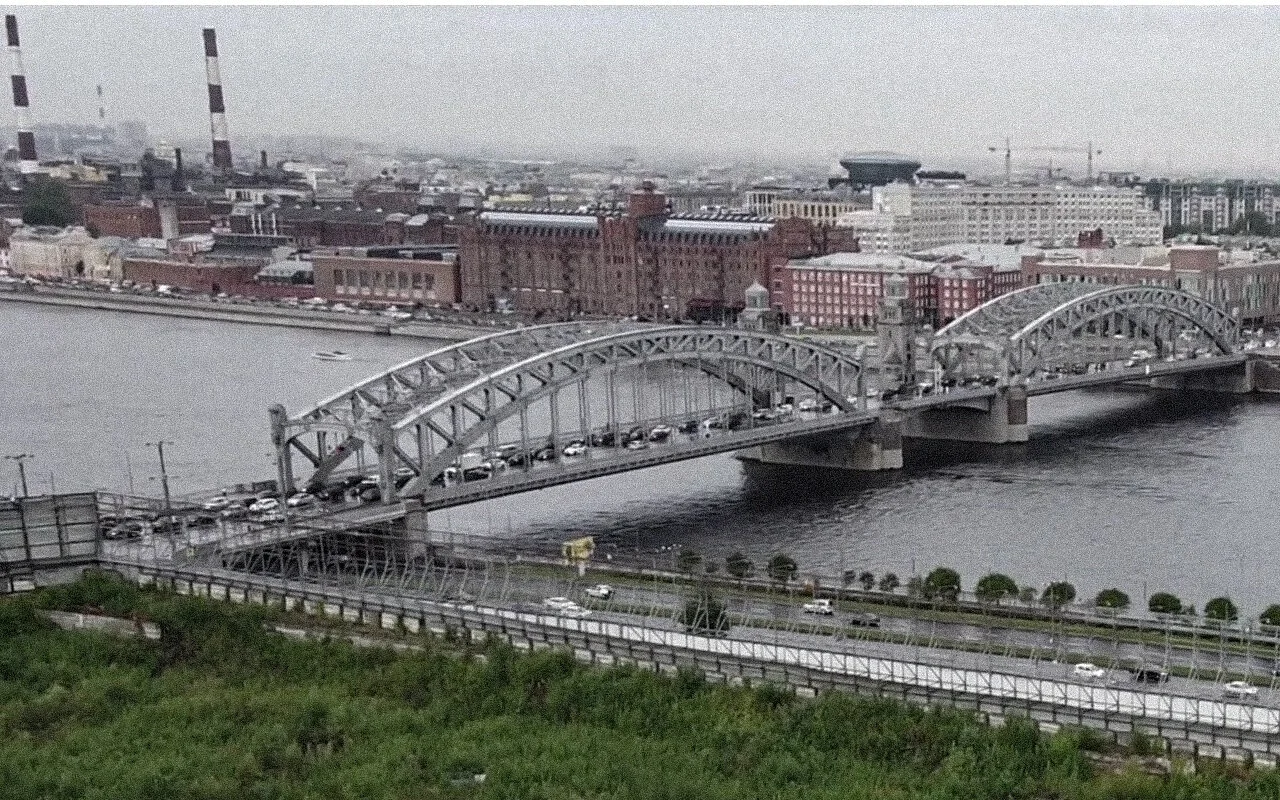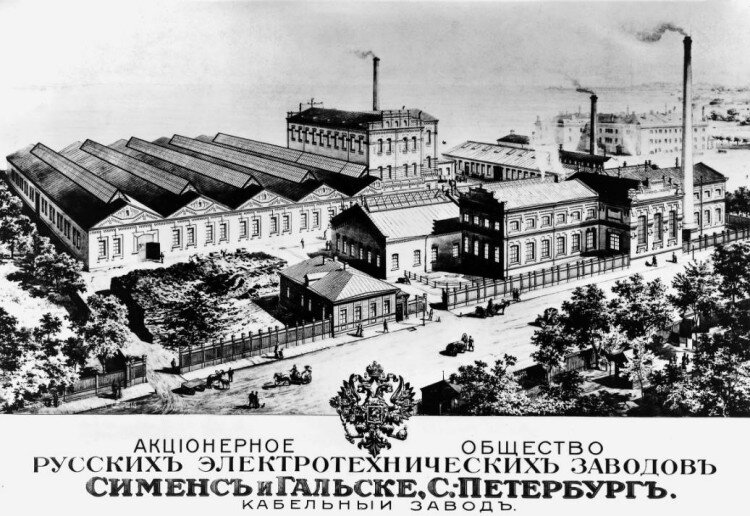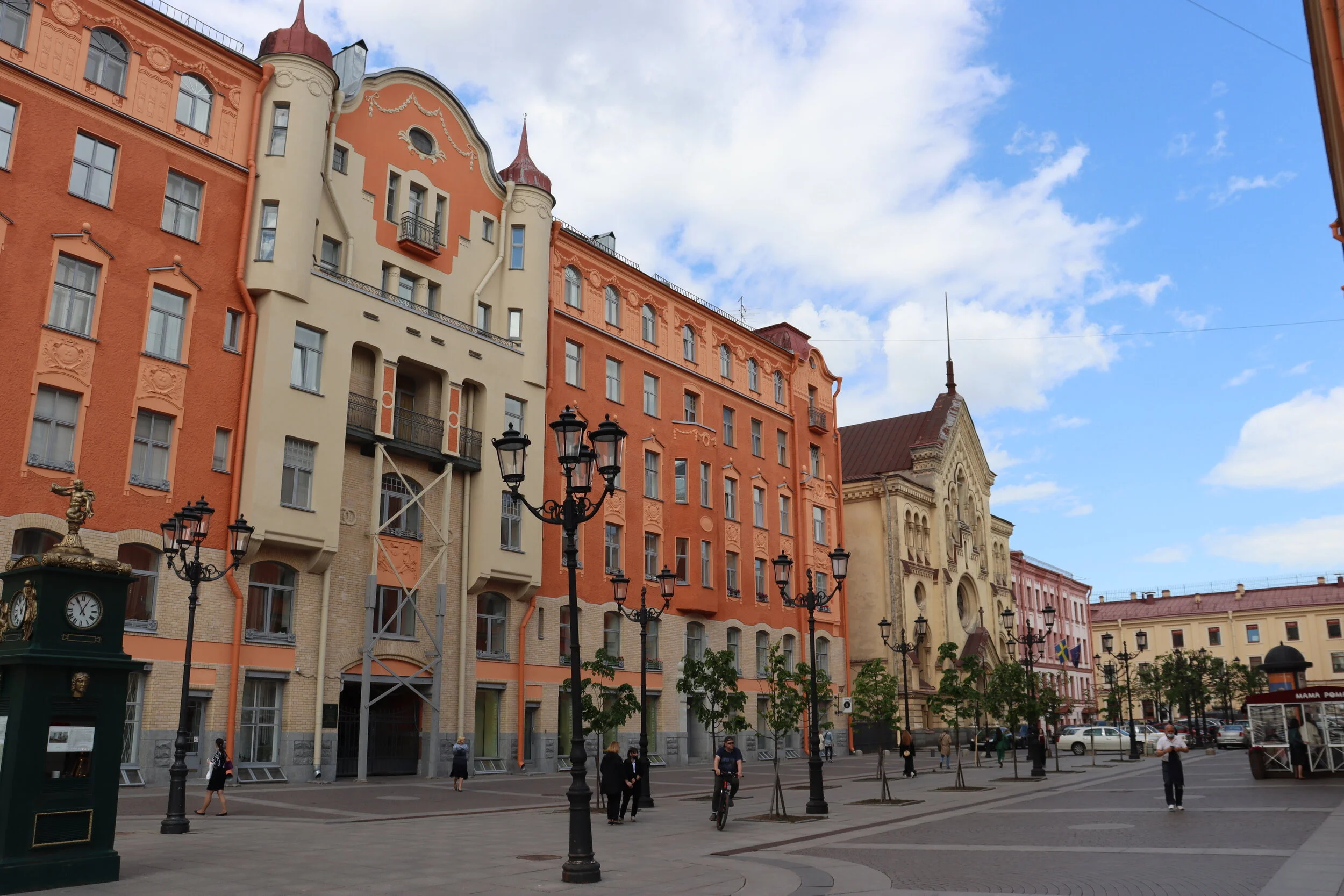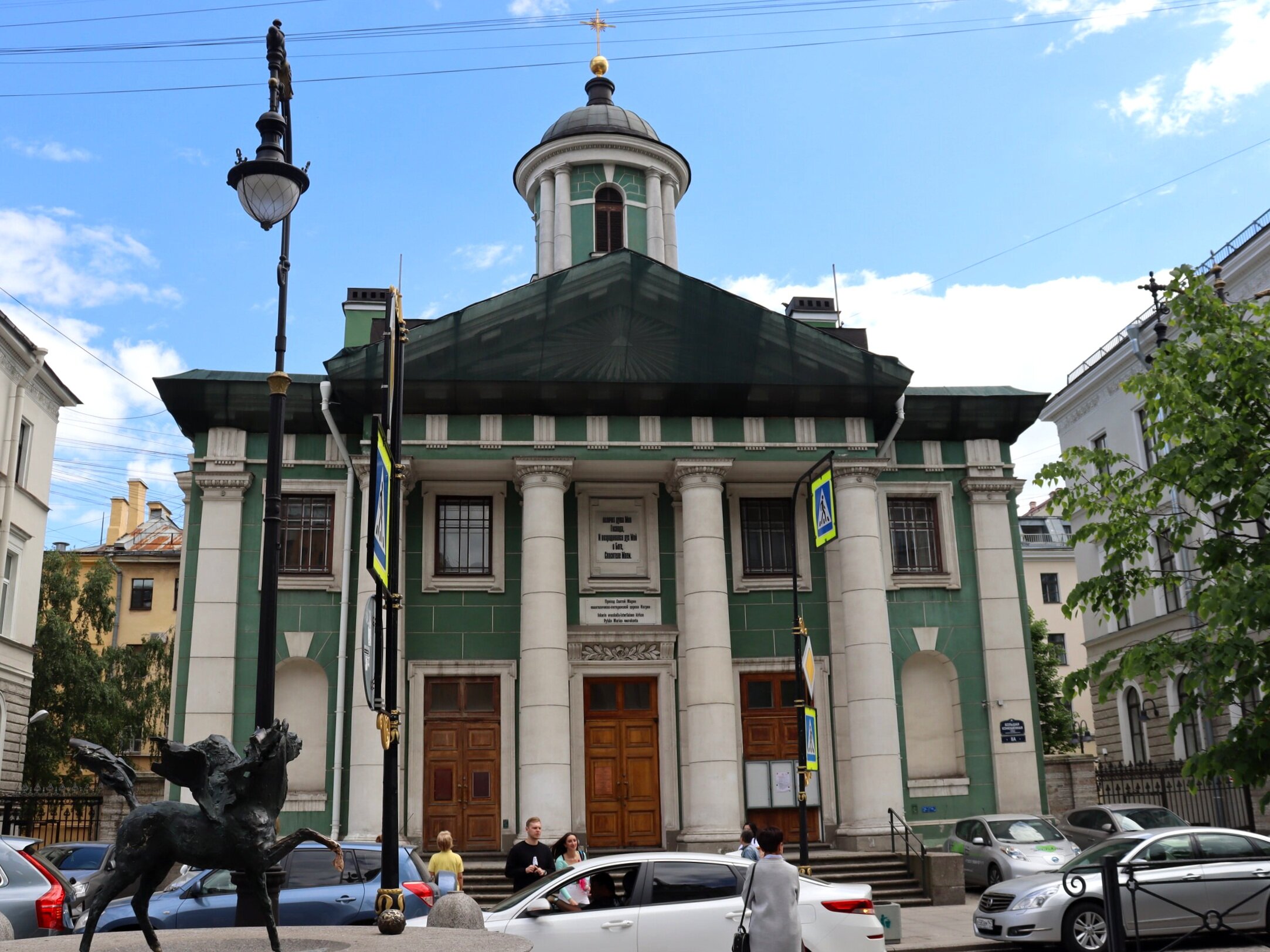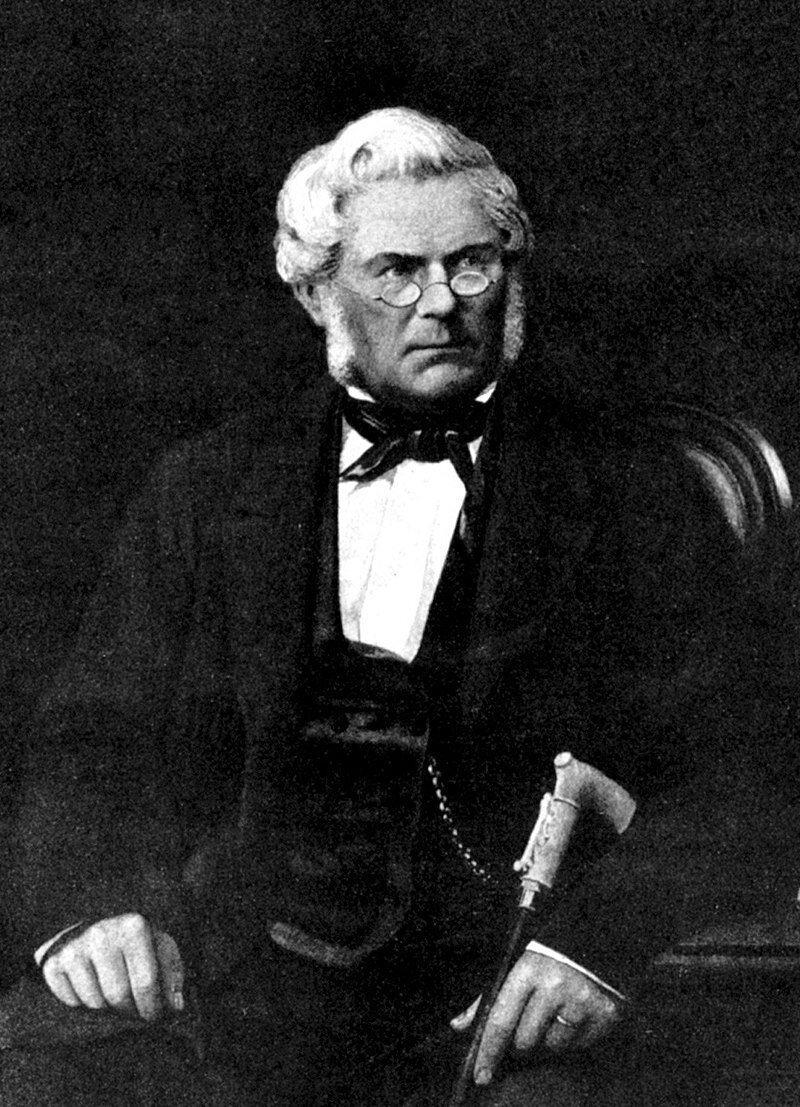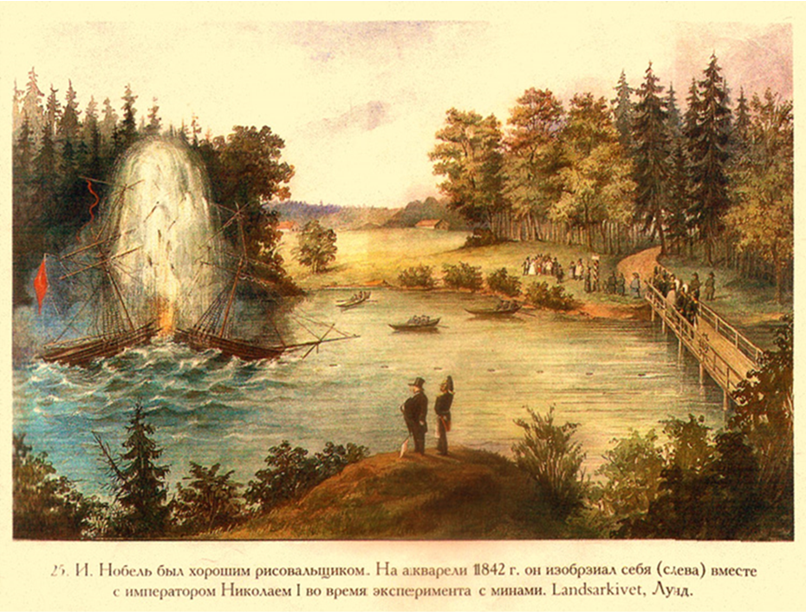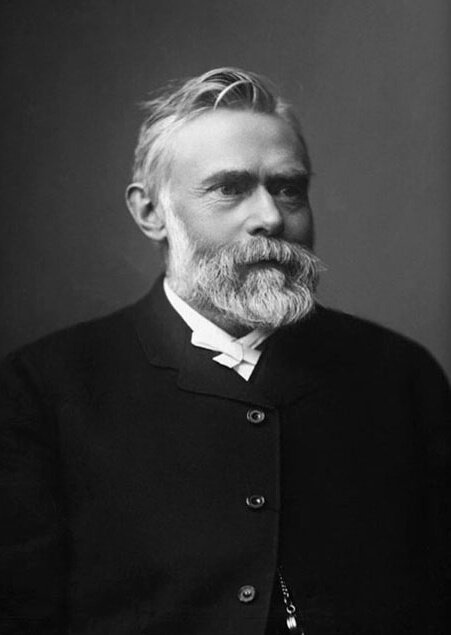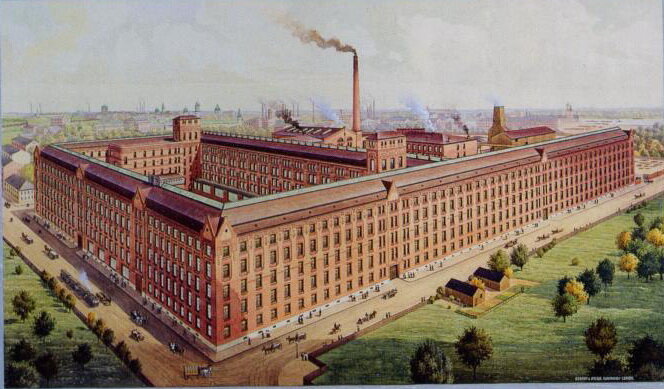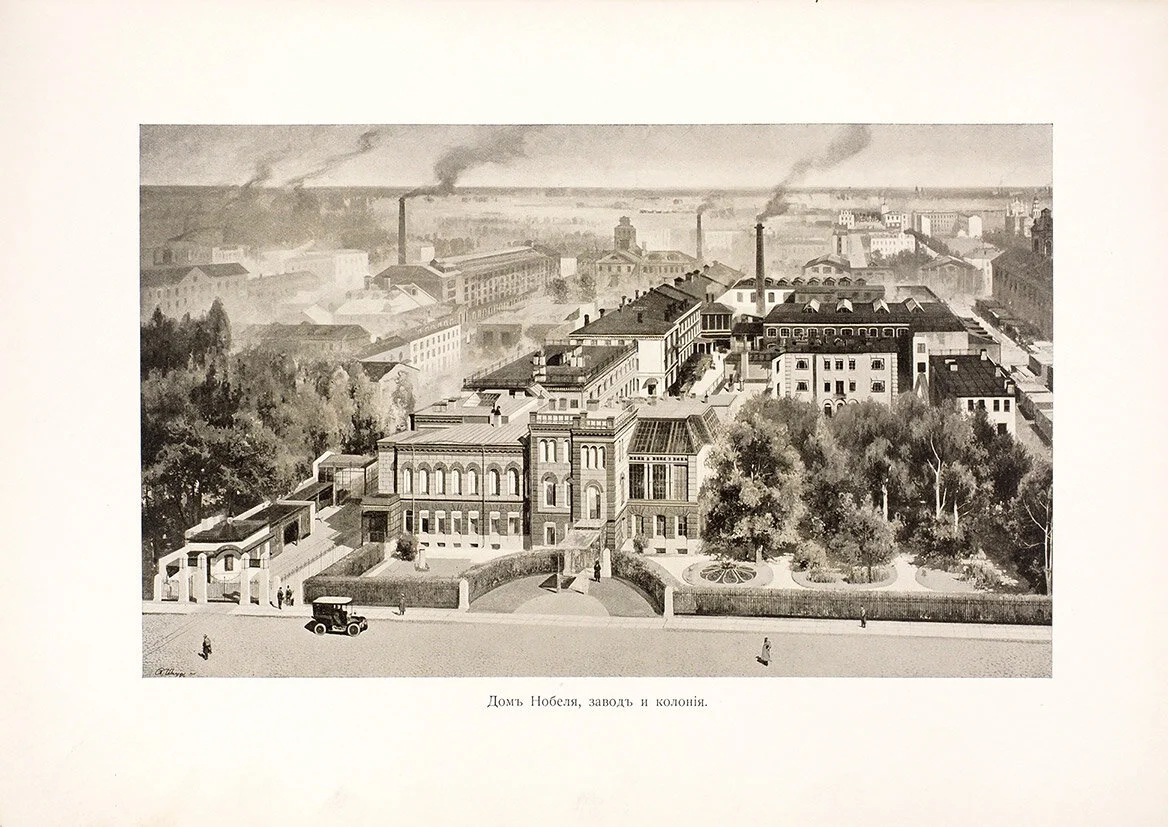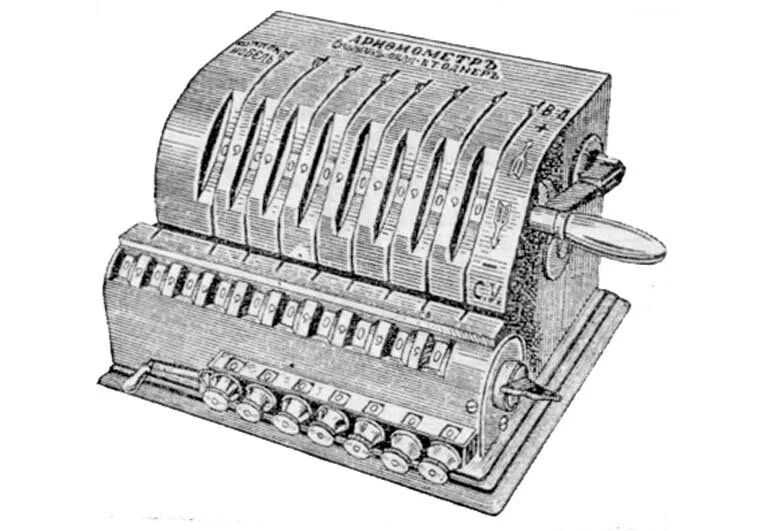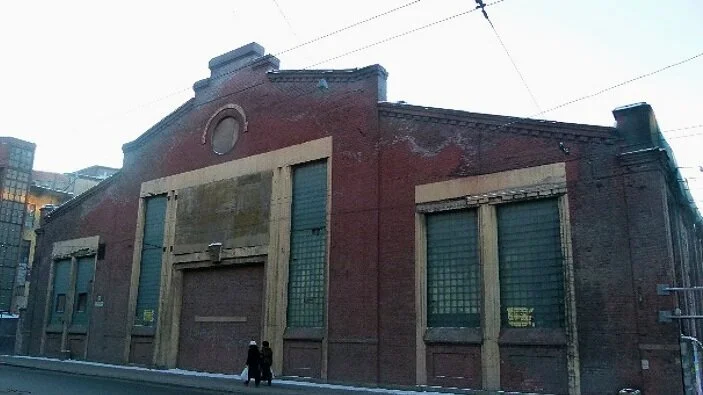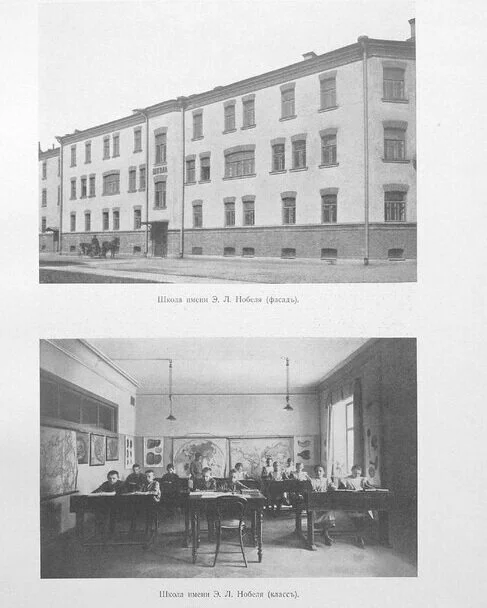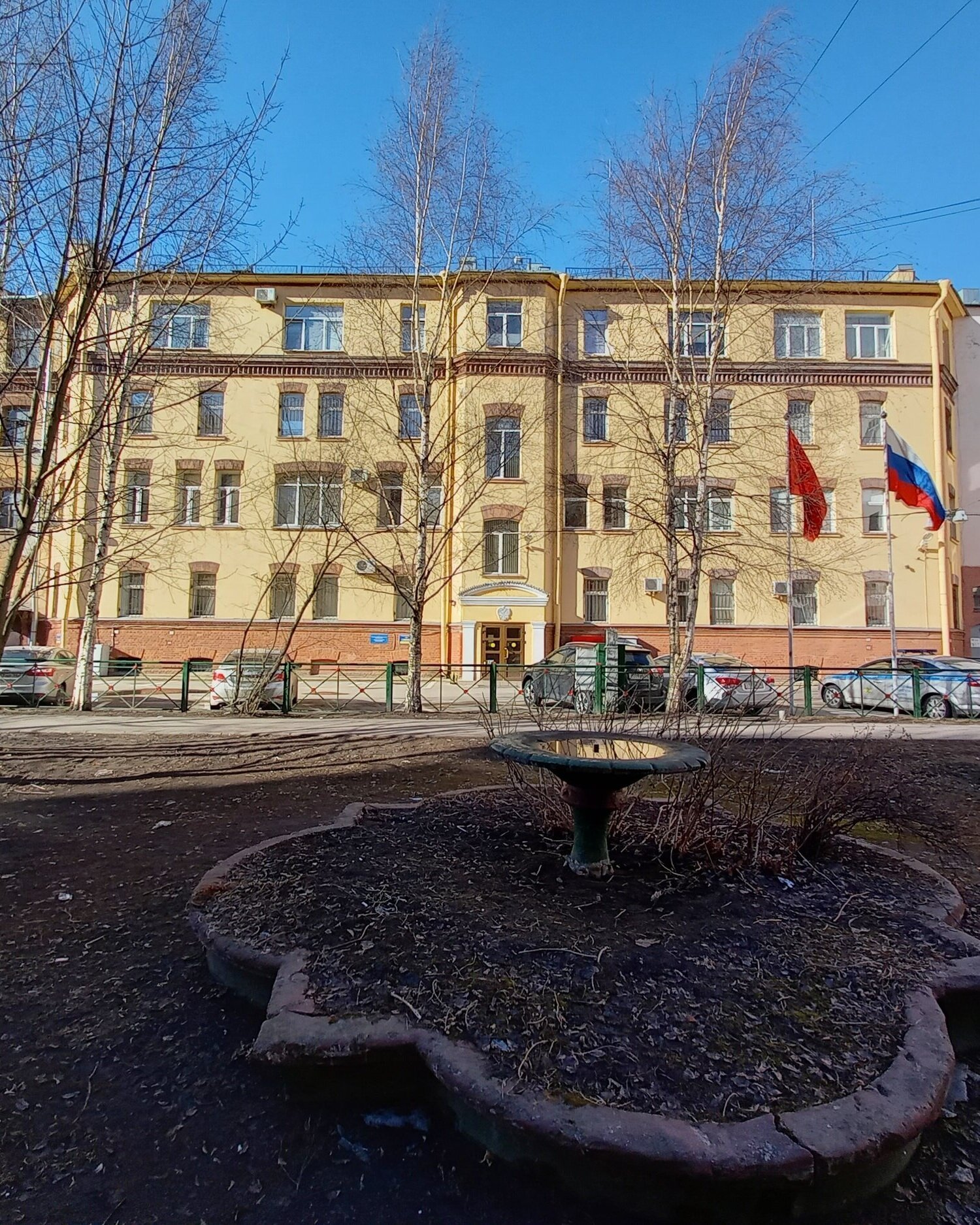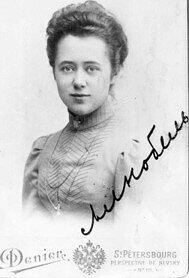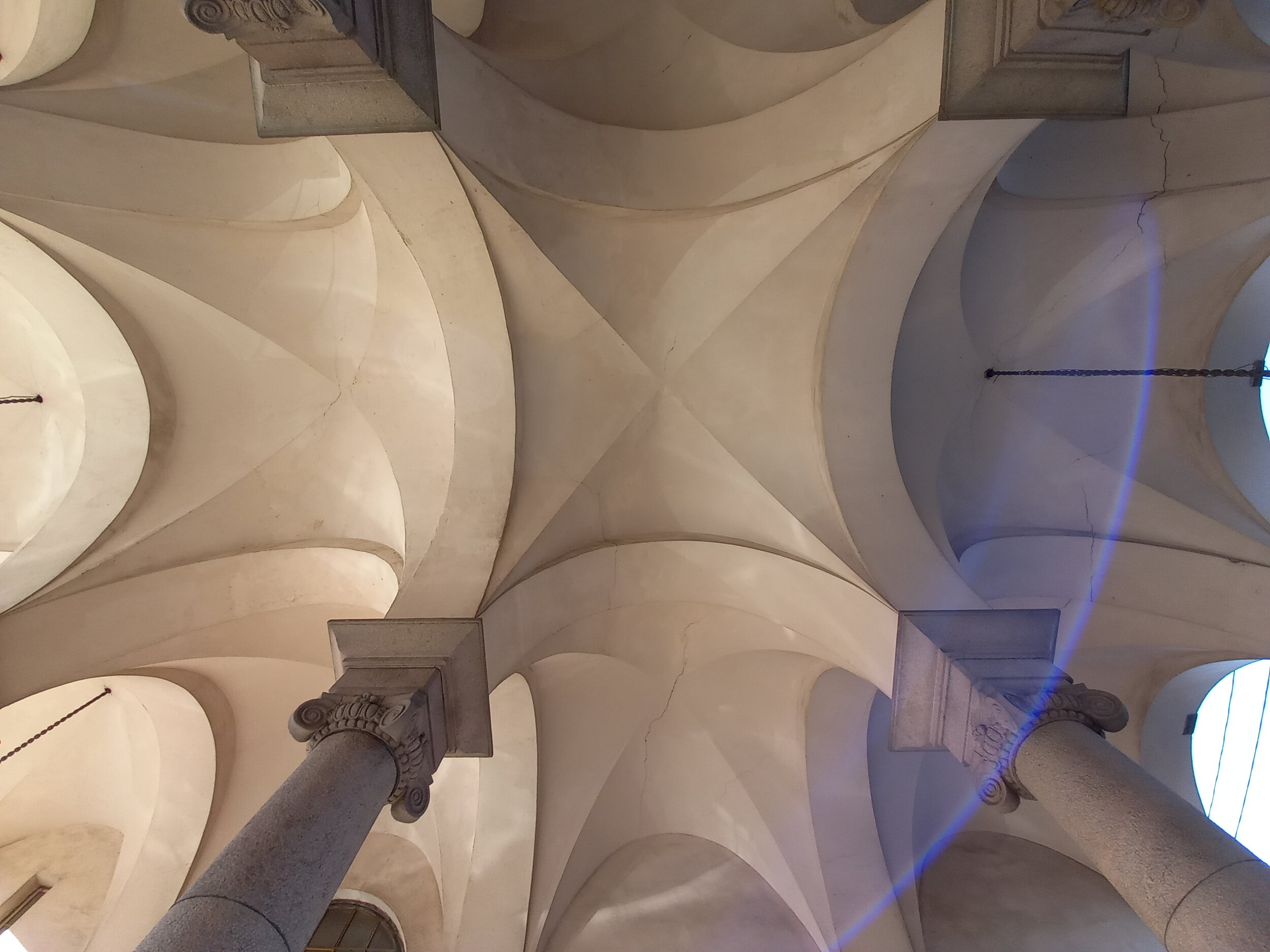Muted histories and re-united memories: Swedish industrial heritage in St. Petersburg
Irina Seits
International Enterprises in St. Petersburg
The house of Nobel, the plant, and the colony (on the Vyborg Embankment). An illustration from The Mechanical Plant Ludvig Nobel anniversary book (1912).
In St. Petersburg, just as in many other places, it was customary to build factories along and in proximity to waterways. This was done for the sake of logistical efficiency. Hence many plants and workshops traditionally occupied the embankments of St. Petersburg’s main water arteria - the Neva River. Even today a large part of the city’s industrial heritage remains within, or beside, the borders of this historic center.
The architecture of St. Petersburg shipyards, foundries, and powder factories, as well as sugar and tar producing workshops, was not less carefully designed than Royal palaces, cathedrals, and residential districts. Everything strictly followed a thought-through city plan proposed by Peter the Great. His attention to detail had set up a standard for a new urban tradition of regular city planning and ‘ensembliness.’
A view to the industrial area in St. Petersburg next to the Bolsheokhtinsky Bridge over the Neva River. Photo by Grigory Brazhnik, 2021.
By the time of the Bolshevik Revolution of 1917, the factories and plants had formed an architectural belt around the historic center. They were neither destroyed nor clamped into a ring of dull quarters; on the contrary, industrial ensembles were added to the diversity of St. Petersburg’s well-designed architectural landscapes. The factories’ pipes and towers contributed to the creation of the city’s skyline and developed picturesque waterfronts that contributed in convincing UNESCO to include the historic center of St. Petersburg into the family of the world’s celebrated heritage sites. During the first two centuries of St. Petersburg the grand classical and redbrick designs of its factories served to promote Russia and its capital as both a dynamic developing wonderland and a technological metropolis, which should have shocked Western neighbors with its emergence at the glimpse of their lazy eyes.
By the middle of the nineteenth century, St. Petersburg grew into one of the world’s largest industrial centers, attracting investors and entrepreneurs from near and far. German, English, French, Belgian, Swedish, North American, and other companies opened their representative quarters in St. Petersburg, while risky entrepreneurs whose possibilities in their homelands were limited, moved to the Russian capital with their families hoping to realize their dreams of getting rich quick.
Siemens & Halske Plant in St. Petersburg.
According to the illustrated almanac on St. Petersburg’s merchant, trade and industrial enterprises, published on the occasion of the city’s bicentennial celebrations in 1903, the number of registered factories and plants of all industries amounted to 631 enterprises and employed nearly 135 000 workers, around 10 % of the city’s population at the time (approx. 1,25 million people).i Considering that the following decade saw tremendous levels of economical and industrial growth in the Russian Empire, the number of industrial companies operating in St. Petersburg had, by the start of the World War I, significantly increased.
About one third of St. Petersburg’s enterprises were owned by Western businessmen. They often commissioned architects who lived and worked in St. Petersburg but shared same international background to construct industrial quarters; and these architects, in turn, respected the traditions of St. Petersburg redbrick-styled industrial architecture.
By 1917 St. Petersburg developed into a truly international city with entire industries heavily dominated by companies from abroad and by foreigners who moved to St. Petersburg with their families to establish business in their new homeland: from jewelry (Faberge, Bolin) and telecommunications (Ericsson) to oil (Nobel) and electricity (Siemens). The presence of foreign entrepreneurs in the city was reflected in glittering signboards that stood above the entrance of factory plants, shops, and boutiques; a diversity of national culinary traditions were on the menu of popular local taverns; different languages were spoken on streets, in restaurants, and at high receptions. A variety of religions were practiced in national churches raised next to the Russian Orthodox cathedrals along the main street of the Nevsky prospect: the Finnish Church of St. Maria; the Swedish Church of St. Catherine; the German Lutheran Church of St. Apostles Peter and Paul, and the Catholic Basilica of St. Catherine.
View to the “Swedish Corner” in St. Petersburg: Malaya Konushennaya Street with the St. Catherine Church (Sankta Katarina kyrka). Photo by Irina Seits, 2021.
The “Finnish” Evangelical Lutheran Church of Saint Mary (Pyhän Marian kirkko) at Bol’shaya Konushennaya Street. Photo by Irina Seits, 2021.
Since the second half of the nineteenth century many countries had opened their national charity foundations in order to support their compatriots settled in the Russian capital. In the beginning of the twentieth century The Scandinavian Charity Foundation, for instance, was headed by Emmanuel Nobel, a representative of the family of “Russian Rockefellers” and one of the nephews of Alfred Nobel.ii Internationalism has been rooted in the urban tradition of St. Petersburg from its very birth and its naming – it was the first Russian city to be given a foreign name.
The Nobels in Russia
The name of Alfred Nobel has become so distinguished, and yet still little is known either about the whole dynasty of the Nobels or their intellectual heritage and overall impact on various aspects of modern life. The story of the Nobel family in Russia is a fascinating drama, the embodiment of the contradictions and trappings of modernity.iii Just like the age in which the family prospered, there was, on the one hand, a devotion to technological progress as the main engine of humanity’s progress, but on the other, an investment in the notion of the intellect drawn from the Renaissance – inasmuch that scientific invention should be the servant of humanity’s physical and spiritual prosperity.
Even though the story of Alfred Nobel’s family is by no means a secret, with many of their inventions widely used around the world, less is commonly known either about their personal biographies or about the revolutionary scientific heritage the family fostered. Moreover, little about the Nobels’ time in Russia, where their industrial and oil empires were born and developed back in the nineteenth century, has trickled into public knowledge. Even though Russian sources on the Nobels’ time in Russia are quite extensive, interest shown in them has mostly focused on the family’s economic activities, technological inventions, and their industrial entrepreneurship.iv Public sources in other languages are even more scarce, and the information on, for example, Wikipedia provides us with just a modest introduction to the family’s major names and a brief overview of their inventions.
Since the beginning of the century interest in the history of the Nobel family in Russia has grown significantly. Brita Åsbrink focuses on the history of the Nobel’s oil enterprise developed in the Russian Empire before the 1917 Revolution and is among the chief contributors to the online Branobel History Project and The Branobel History Digital Archives,v that collected over 50 000 digitalized documents related to the Nobel’s oil industry as well as publications on biographies and inventions of the Nobel brothers. In 2001 Brita Åsbrink published a book Ludvig Nobel: ”Petroleum har en lysande framtid.” En historia om eldfängd olja och revolution i Baku [Ludvig Nobel: “Petroleum has a bright future”],vi which remains the most exhausting source on the Nobel’s oil business and family life in Baku.
The Administrative building of The Branobel at the Griboyedov Canal in St. Petresburg; a former mansion of M.A. Gorchakov rebuilt by Fredrick Lidvall for the Nobel’s company in 1909. Photo by Irina Seits, 2021.
A number of profound monographs that explore on the Russian period of the Nobel family were recently published in Sweden and Russia: Nobel: den gåtfulle Alfred, hans värld och hans pris [Nobel: the enigmatic Alfred, his world and his prize] by Ingrid Carlberg (2019)vii; Immanuel Nobel & Söner. Svenska snillen i tsarernas Ryssland by Bengt Jangfeldt (2020),viii and a Russian translation of the 1952 book by Marta Helena Nobel-Oleinikoff Ludvig Nobel och hans verk. En släkts och en storindustris historia [Ludvig Nobel and his work. The history of a family and a large industry],ix published in 2020.x
How, then, could it have happened that, setting aside the founder of the Nobel prize, the “Russian Rockefellers,” as they were called at the beginning of the twentieth century, had been half forgotten during the most of the twentieth century? Why, for example, was it so little known about Alfred’s brothers, Ludvig and Robert, who were no less talented and intelligent, and without whose support, neither the dynamite nor the prize could have ever existed?
Even though the historical narrative about the history of the Nobel family in Russia is well written, it has yet to become a common heritage of both Russia and Sweden. If one visits today the Nobel Prize museum located in the heart of Stockholm and walks through its halls that tell the story of Alfred’s life, she will find only a brief mention of Alfred’s connections to St. Petersburg, even though it was a town where he had spent his childhood with his parents and his siblings, where he received his early education and was introduced by his chemistry teacher – a prominent Russian scientist Nickolay Zinin – to experiments with nitroglycerine.
Moving to Russia
Immanuel Nobel (1801 – 1872) was a founder of the whole dynasty of talented Swedish inventors. Coming from a simple family, he had become a ship boy at the age of 14. He then moved on to become a sailor on a trade ship, allowing him to explore the world. Upon returning to Sweden Immanuel Nobel studied construction. He was later noticed by the king Karl XIV Johan for building a triumphal arch in his hometown Gävle. This royal recognition helped Immanuel continue his architectural education in Stockholm. At the same time, he was interested in inventing various mechanisms from war equipment to prefabricated sectional housing. As Britta Åsbrink mentions in her article on Immanuel’s biography for the Brothers Nobel online project, “Immanuel Nobel was always more interested in the inventions than the financial gains, forcing him into several bankruptcies.”xi
Immanuel Nobel (1801-1872).
After Immanuel’s financial situation in Sweden had worsened, he tried his luck in Finland. In 1837, upon receiving an invitation from the Russian government to demonstrate his underwater exploding mine, he came to St. Petersburg. His visit was successful. Immanuel, being also a talented artist, depicted in watercolors an explosion of his invention that he had observed together with Grand Duke Mikhail Pavlovich, one of the brothers of Tsar Nicholas, at the Okhta River, not far from the burial site of the Nyenschantz fortress.
“An underwater mine explosion in presence of His Imperial Majesty Grand Duke Mikhail Pavlovich in 1837.” An illustration from the Mechanical Plant Ludvig Nobel anniversary book (1912).
In the following year Immanuel Nobel opened a mechanical workshop in St. Petersburg, working on state commissions for various war machines. In 1842 Immanuel’s wife Andriette Ahlsell and their three sons Robert, Ludvig, and Alfred joined Immanuel in the Russian capital. It was there that in 1843 their youngest son Emil was born.xii Together with the Russian entrepreneur Nickolay Ogaryov, Immanuel Nobel had founded a mechanical wheel factory in St. Petersburg, which in 1851 was transformed into the company “Nobel and sons.” The plant thrived during the years of the Crimean military campaign as one of the main suppliers for the Russian army. However, after the army had been defeated, and sanctions imposed by the West severely restrained Russian military production, Immanuel faced the threat of another bankruptcy and left St. Petersburg for Stockholm together with his wife and their youngest sons Alfred and Emil.xiii
“The house and the office of the Ludvig Nobel Plant in the first years of its existence.” An illustration from the Mechanical Plant Ludvig Nobel anniversary book (1912).
Even though Alfred left St. Petersburg to continue working in Sweden, his brothers Robert and Ludvig, and later Ludvig’s son Emanuel, who was born and raised in St. Petersburg, secured the growth of the Nobel’s empire. The format of the present essay does not allow to list all their inventions. Developing his father’s plant, Ludvig and his brother Robert Nobel founded the Branobel company in Azerbaijan, a part of the Russian Empire at that time, which soon produced half of the world’s oil. Ludvig designed the whole infrastructure for his oil empire based in Baku. Not only did he invent the world’s first oil tanker Zaratustra (Zoroaster) but he also improved pipelines and railroads to transport oil from Baku to St. Petersburg. Ludvig ran his successful business both as a scientific hub and a successful social experiment.
Zoroaster, the first oil tanker (1878)
Immanuel Nobel, residing in Sweden, kept his habit of recording important events of his life in watercolors until his death. The theme of explosions returned in his painted diary in 1864 when tragically his youngest twenty-two year old son Emil died from an accidental explosion at the family laboratory in Stockholm. Immanuel did not recover from this tragedy, dying on September 3, 1872, precisely on the day of the eighth anniversary of Emil’s death. As a family legend tells us, he passed away holding a finished watercolor drawing of an explosion in his hand.
Even though the original enterprise founded by Immanuel Nobel in St. Petersburg did not survive, his sons inherited the talents of inventors and entrepreneurs. The famous mechanical plant “Ludvig Nobel” was established in 1862, when Immanuel Nobel’s elder son Ludvig fulfilled his obligations to his father’s creditors and was free to start his own business. Immanuel’s sons would often refer to their father’s life in St. Petersburg as foundational for their own successful industrial empire. By the beginning of the twentieth century, already after the deaths of all the four brothers that had built one of the world’s biggest industrial giants, the Nobel family started arranging the achievements of their fathers and grandfathers into their own family heritage.
Ludvig Nobel (1831-1888)
Building their own legacy and joining Russian history
Besides developing their own business-empire, the Nobels built their heritage by means of financing and heading various national committees and foundations, actively participating in their communities as scientists, investors, and inventors, among which were The Imperial Russian Technical Society and The St. Petersburg Society for Promotion and Improvement of the Factory Industry (since 1906 - The St. Petersburg Society of Factory Owners and Manufactures). The Nobels consciously interweaved their family legacy into the fabric of Russian industrial, economic, and social history. They were proud of possessing the honor of placing the Russian Imperial Coat-of-Arms on their plant’s emblem – the sign of the highest possible recognition from the state. Now, at the turn of the new century, the family were well established, respected, and famous, and they started publishing special editions on the history of their industries with detailed reports about their own activities and achievements, on the one side, and, on the other, would present their own theory of fair capitalism and social security. One of the artifacts of the Nobel heritage was a book published in 1912 for the fiftieth anniversary of the “Mechanical Plant Ludvig Nobel.”xiv
Make it stand out
The title page of The Mechanical Plant Ludvig Nobel anniversary book (1912).
This edition was not simply a gift book, it was a serious report on the history of the half-century operation of the plant. At the same time, it introduced an already well-established narrative on the family history and on the origins of their Russian Industrial Empire. The book was evidence of the unique heritage of an immigrant Swedish family in Russia and, specifically their own family legacy, which they now considered as a valuable part of Russian national heritage, more generally. Immanuel Immanuilovich Nobel was cherished as the founding father in this already mythologized story of the Russian Rockefellers, a legendary figure, whose life represented an ideal of a cosmopolitan inventor and a scientist always searching for the truth and working restlessly for the sake of humanity. The book describes:
Twice endured he the vicissitudes of fate, twice was he enormously rich, and he died, leaving his sons no fortune; but instead, he raised them in respect and love for the labor and left his inquiring mind and the spirit of permanent search for the new forms as his legacy.xv
Producing heritage for the city
By the time of the Bolshevik Revolution in 1917, the Swedish population of St. Petersburg had reached 10 000 people, among whom were many talented engineers, architects, jewelers, musicians, and writers.xvi The Viborg Side of St. Petersburg was established as an industrial area, from the beginning of the city’s development. The road from here leads to the former Finnish town of Vyborg and to the territory of contemporary Finland. Thus it is no surprise that this land developed under the influence of both Swedes and Finns who had moved to St. Petersburg. The Swedish industrial giants – mechanical plant Ludvig Nobel and The Telephone Plant L. M. Ericsson and Co. – dominated the landscape of the Vyborg side along with their neighbor – another mechanical and machine-building plant Gustav Lessner, founded by the German-Swedish entrepreneur.
The Telephone Plant L. M. Ericsson and Co. in St. Petersburg. A postcard from the 1910s. A view to the Nobel Plant.
Good neighborly relations were established on the Vyborg Side between the compatriots. In 1912 Ludvig Nobel and Gustav Lessner even founded a joint company Noblessner and a ship-building plant in Tallinn. Neighbors supported each other in times of trouble, when e.g. Eriksson’s family helped Alfred Nobel with financing his studies in the United States once his father lost his wealth. The good deed was later repaid in 1868, when Willgodt Theophil Odhner, a young mechanic from Dalby, the Värmland province of Sweden, and a distant relative to John Ericsson, arrived in St. Petersburg with only eight rubles in his pocket. The twenty-three-year-old student of the Royal Institute of Technology in Stockholm had to quit his studies after his father’s death since he could no longer pay for his education. Inspired by an article he had read in a Swedish newspaper about the family of Immanuel Nobel, who left Sweden for Russia in order to escape from a debt-hole and soon reached financial success, Odhner decided to try his luck.
Upon arrival in the Russian capital, Odhner had a chance to meet Ludvig Nobel who offered him a job at his plant. The talented guy soon became a master. Once Ludvig Nobel gave him a broken mechanical arithmometer, an invention by the French entrepreneur Charles Xavier Thomas de Colmar, to repair. Odhner, unfamiliar with the device, not only fixed it, but developed his own mechanical calculator, which became the most popular in the world until the invention of electronic calculators. The first Odhner arithmometer was produced at Ludvig Nobel’s plant in St. Petersburg in 1877. Some years later Willgodt Theophil Odhner founded his own plant in St. Petersburg and realized the dreams of his poor youth.
Odhner Arithmometer, original design.
Building an urban paradise
Nobel’s mansion on Vyborgskaya Embankment had become the center of Scandinavian life in St. Petersburg, where Selma Lagerlof, Karl Mannerheim, Adolf Erik Nordenskiöld were among its famous visitors. The building of the living mansion and the company’s office was designed in neoclassical style by the Swedish architect Сarl Anderson in several stages between 1870–76. In 1902-03 it was enlarged by Robert Friedrich Meltzer. Together with another famous architect of Swedish origin – Fyodor (Fredrik) Lidvall these architects reconstructed the industrial district owned by the Nobels into a new urban unit that included the plant, the owner’s living quarters combined with an administrative office, and the innovative “living colony” for the company’s employees.
View to the Nobel’s mansion on Vyborgskaya Embankment. An old postcard.
Ludvig Nobel developed a new housing system, which later was called the “Nobel’s system” or the “Nobel’s workers’ town”. Together with his son Emanuel they reworked the ideas of garden cities and experimental British workers’ settlements in order to apply them to the conditions of a densely populated urban landscape. The housing estate was located in immediate proximity to the plant, which was reconstructed by Lidvall –a master of elegant Northern Modern style – into proto-functionalist units. In 1912 Lidvall covered the working space of the iron-foundry’s shop with reinforced concrete trusses – a progressive technique for that time, that laid the grounds for the functionalist method of the 1920s. It allowed to organize a large open working space within a shop, providing it with good ventilation and increasing the efficiency of production.
Iron-foundry shop. Photo by Irina Seits, 2021.
The housing estate was built nearby, around the Lesnoy prospect. Architects of German origin Victor Schröter, Robert Meltzer, and their Swedish colleague Lidvall (all of whom lived most of their lives in the Russian Empire), built a complex of 13 two to four storey apartment blocks with centralized water supply, heating systems, “and other attributes of the modern comfort”xvii for over a thousand tenants.
The whole complex was designed in Art Nouveau style, which in St. Petersburg had developed under the strong influence of Nordic Finnish and Swedish architecture, thus receiving the name “Northern Modern”.
The Nobel Town Blocks. Photo by Irina Seits, 2021.
The revolutionary feature of this realized plan was the rejection of the principle to build houses along the closed perimeters, forming the so-called yard-wells. It was a traditional method of housing construction in Europe, which allowed to save on costs, but which was fertile ground for tuberculosis and other diseases, since no sunlight and fresh air could reach the residents.
The connection between poor health and living conditions of yard-well constructions was already admitted at the beginning of the twentieth century, and yet avoiding the yard-wells required either strict regulations from the state or it depended entirely on the commissioners’ good will. The Nobels believed that rational and healthy organization of living spaces not only complied with the principles of “fair capitalism,” but that the optimization of living spaces rationalized people’s routines, which in turn made them more productive, increasing the company’s profitability.
Later, in Weimar Germany and early Soviet Russia, the yard-well construction was officially proscribed. It was replaced with the so-called line-building, when long ribbons of houses were located parallel to each other, ensuring free air circulation and sunlight between blocks, and where flats occupied the whole width of the house to allow for cross-ventilation.
Ludvig Nobel and his son Emanuel, who headed the family plant at that time, took personal responsibility to organize the living conditions of their employees. Even though they could not practice line building within a small district tightly surrounded by living and industrial quarters, they insisted on building free-standing living blocs – something that was nearly unprecedented in St. Petersburg at that time.
Each house received a unique Northern Modern design; apartments were rationally planned, while spaces between blocs were filled with green areas. The flats in the apartment blocs were given to the plant’s workers and highly skilled specialists (many of whom were of working class origin) as part of a reward system developed by the Nobel brothers. The settlement’s description in the plant’s anniversary book is personally written, filled with satisfaction and pride about the project:
The houses are separated from each other by shadowy little gardens, and the whole colony with its friendly appearance, its coziness and quietness make one forget about the noisy city, even though it is located in its busy industrial part.xviii
A school for the plant’s children, both girls and boys, for workers and managers alike, was located in the living district. It was first opened in September 1901, and by the 1917 Revolution had 200 students. The schools funded by the family were soon opened in each “Nobel town” around the country, while the best students, regardless of their social origin, continued their education at the Universities with support from special company scholarships.
Left. School and a classroom at the Nobel Town. An illustration from The Mechanical Plant Ludvig Nobel anniversary book (1912).
Right. Building of the former school. Photo by Irina Seits, 2021.
The Nobel brothers emphasized the importance of their social projects and enhanced the prestige of education by commissioning Robert Meltzer, one of the most fashionable architects in St. Petersburg at that time, to design a St. Petersburg school. In the words of the owners, the school named after Immanuel Nobel is “an example of cleanliness and order” that produces environment full of light and “pleases an eye with the coziness and absence of a stereotyped routine.”xix
Besides the building itself, the school introduced further innovations: a doctor’s room, where “a specially invited woman monitors children’s health”xx and a facility, which was “unique in its own sort – the kitchen-canteen for the students,”xxi a prototype for future constructivist factory-kitchens.
After Ludvig’s death, his son Emanuel took over the administration of his family’s industrial empire. His own mansion was built by architects Meltzer and Lidvall in the same workers’ district, thereby stressing his egalitarian impulses. Each façade of the modestly-sized house resembled a unique Art-Nouveau design. An Art-Nouveau styled fence connected the Nobel’s mansion to another building, which was an innovative type of a social institution for Russia: the so-called “People’s House.” This type of public educational and entertainment building was after the Bolshevik Revolution transformed into a “House” or a “Palace of Culture.”
Mansion of Emanuel Nobel. Photo by Irina Seits, 2021.
It was also the architect Meltzer who in 1897-1901 had built the People’s House as an entertainment and educational center for the plant workers, managers, and Nobel family members. All children from the area had access to the garden with a tennis court located next to the People’s House. During winters an ice-skating rink and an ice hill were arranged for the kids.
People’s House. Photo by Irina Seits, 2021
Ludvig’s daughter Marta Nobel-Oleinikoff, the first woman in the family to marry a Russian, was a professional doctor and one of the Europe’s first female surgeons. She took care of a special hospital and a rehabilitation center for the colony’s children and adults.
Marta Helena Nobel-Oleinikoff (1881-1873)
All members of the community, big and small, and regardless of social class, participated together in different activities, e.g. discussing books and interesting publications, staging theatrical performances in the People’s House, etc. There Ludvig Nobel arranged a library accessible to all his employees, and provided rooms for different activities: a billiard hall, a lecture/concert hall, etc. The main idea for the elegant house was that it be used as a public space for all members of the community.
It was here, on October 30, 1901, that Ludvig’s son Emanuel Nobel demonstrated a diesel engine in operation, after he had bought the license from Rudolf Diesel in 1898 and improved it to make it operate on petrol instead of kerosene.
The hospital, the pharmacy, and some shops were located in the district, turning it into an island of “fair capitalism.” The architectural jewel of the whole area is the so-called “profitable house” – an apartment bloc designed by Fredrik Lidvall in Northern Modern style, where flats were rented out by the Nobel family to richer tenants. The architecture of the building resembles both the Italian Renaissance palazzos and old Swedish mansions.
The Apartment ‘profitable’ house. Photo by Irina Seits, 2021.
The district was like a materialized urban utopia, where humble capitalists lived happily and in peace with their workers, taking care of their wellbeing and supporting them in their individual and collective development. It is hard to say how long it would last and where it would lead, but an effort to realize another - communist - utopia (the Bolshevik Revolution) ended the Nobels’ social experiments in Russia, forcing them to flee from the country and to leave their wealth, their projects, their inventions, and their unrealized fantasies behind in the land that had been their family home for eighty years. The heritage that the Nobels left in St. Petersburg and across the Russian Empire was gone with the wind of turbulent times, sent into internal exile for the decades of oblivion and neglect to come.
The arcade of the apartment ‘profitable’ house. Photo by Irina Seits, 2021.
Sharing the national drama
It is not easy to imagine the dramaturgy of the situation, of what Gustaf Nobel, a great-grandson of Ludvig Nobel, called “a total change of paradigm”xxii and of what the Nobel family, along with many other international entrepreneurs, had gone through by the time the Bolshevik Revolution took hold. A definite line had thus been drawn between the life of the family before and after October 1917.
On both sides of these new times – both in the new Soviet Russia and in Western Europe, specifically, in Sweden – the history of the Russian period of the Nobel family was muted, while the heritage that they had left in Russia was either neglected or reserved to study by specialists only. A heritage does not exist if it is not remembered and acknowledged as such. The story of the Nobels became one among many around the country, a case that contributed to the development of systematic forgetting and neglect, used as a strategy to construct and propagate the new communist ideology and heritage fabrication. Ultimately the Bolsheviks confirmed what Lowenthal noted on the matter: “at its best, heritage fabrication is both creative art and an act of faith.”xxiii The oblivion of the past produces, in its absence, faith. History had not existed before the Bolshevik Revolution. This is proved by the absence of the material heritage of that history, which no longer existed because no one recognized it as heritage and thus as evidence of a history preceding the Revolution.
The Nobel’s plants were nationalized, and the realized fantasies of a social paradise - the “Nobeltowns” built along the oil routes and filled with fruit trees blossoming on previously deserted lands – were destroyed or came into dilapidation in just a few years after their owners had fled the country.
The former Ludvig Nobel Plant (Russian Diesel Plant). Photo by Irina Seits, 2021.
The ideological drive of the Bolshevik Revolution – to destroy the past, to divorce the present from previous experiences and forms of heritage in order to start anew – not only meant the literal destruction of the previous era’s material heritage, but it targeted the destruction of memory, by divorcing the present from history itself. These were not only the achievements by actors of the past that were to be undermined and neglected, but these were their very names that were to be forgotten and erased from a new reality. Soon after the Bolshevik Revolution, the Ludvig Nobel plant was re-named the Russian Diesel Plant, thus eliminating the very name of the Nobels from the “new paradigm.”
The technological achievements and the whole organization of the Nobel’s enterprises were declared the achievements of the new Soviet regime, while the family’s contribution to the country’s economic and technological development was severely undermined even in the professional studies and reports by the Soviet scholars. As a result, the Nobel’s heritage was forgotten in the Soviet Union and their name was connected only to the international prizes established by Alfred Nobel.
A researcher on the Nobels, Vladimir Meshkunov, states that “unfortunately, later everything had been done to undermine the role of the Nobel family in the development of the Russian mechanical engineering and oil industry.”xxiv He admits the willful ignorance of the Nobel’s patented inventions within Soviet publications. And when various technological achievements, which were realized at the Ludvig Nobel plant, are in fact mentioned, they are, continues Meshkunov, often referred to as the products of the Russian Diesel plant – a name given to the factory after the Revolution. While the Ludvig Nobel plant is merely listed among others, he notes, the Russian Diesel plant is introduced as the central Soviet scientific hub. Thus readers get an impression that two different plants are spoken about.xxv
The Nobel’s housing estate in St. Petersburg was also nationalized, and apartment blocs were subject to the new norms of housing distribution, forming the so-called obschezhities and kommunalkas – apartments that were shared by several tenants who received housing based on the principle that each person would be given eight square meters of personal living space.
It is only by chance that the contemporary residents of the Nobel’s town in St. Petersburg are aware of the history of the estate and its impact on the further development of urban planning and mass housing production in Russia. The owners’ mansions were turned into public institutions, leaving unacknowledged the history of the place. The thread of history linking material objects –in this case buildings to their creators was severed. Principles of historical montage were applied to cut this heritage off from the Soviet narrative hegemonic at that time.
The long decades of neglect of the Nobel’s material and scientific heritage made the area invisible within the contemporary urban landscape, reducing it to a state of non-existence; little information about the Nobels living in Russia or their heritage was ever promoted among the general population or the academic communities during the Soviet times. Not only would contemporary passers-by not see many of the buildings that required renovation as part of the city’s valuable heritage, but the district’s residents remained indifferent. The reality was that special attention given to these architectural objects would only compound the miserable existence of the residents, pulling the buildings out of any context and any connection to the present appearance of urban spaces in the area. Rather than inducing any feeling of empathy in the hearts of inhabitants, the mute and nameless urban ruins, when neglected, were just devalued in their eyes.
Oblivion as remedy
On the other side of the iron curtain the Russian history of the Nobel family had also been muted, but as a traumatic experience. Revolution turned the Nobels into refugees trying to escape arrest, fleeing the country in severe winter conditions, risking the lives of their young children. Thus, members of the Nobel family, who were born already outside of Russia were already alienated from their family’s Russian background. As Gustaf Nobel notes:
I wasn’t really a participant in any affairs regarding Russia, because — you know the history — my family: my father, Gunnar Nobel had to flee from Russia with his brother Alfred, his little sister Nina, and mother Eugenie, as did my grandfather Gösta Nobel, who was not with them in Baku at that time; he was in St. Petersburg. Emanuel Nobel also left the country. They had to flee, and they were on the run for one and a half months. Afterwards my father never talked about it for the rest of his life. Up until his death he said nothing. He would say, “I don’t want to talk about it”. So, we didn’t hear much about Russia or the Revolution from him. But then his brother, my uncle, was a bit more open about it because he was three years older than my father… So, we had a little information from him, but not much, really. Russia wasn’t very present when we were children. But as we grew up, we became more interested in the history, of course, and we started studying it to a certain extent. Growing up, there was not very much to say about it, since no one talked to us about it.xxvi
The exclusion of such a huge part of the family’s heritage was a symptom of a trauma that could not be cured, only repressed. Thus the attempt to connect back to a time and geographical spaces that were irretrievably lost was clearly impossible. To accept it and to have it fore-given by those who possessed neither experience of what was lost, nor the memories of it, could be achieved only through oblivion, as Lowenthal notes: “in nations as in families, to forget can be to forgive.”xxvii
The Nobels hence collectively shared the ultimate loss of their material and cultural heritage, an experience that all citizens of the country had gone through as a consequence of the Revolution. A huge part of the Empire’s population, especially those who owned something, became refugees or were exiled within the state that grew on the lands of their former homeland. The other half of the population became internal migrants. They were alienated from their traditional backgrounds, when forced to leave their native villages for alien cities and vice versa, escaping to the countryside from both hunger and civil war; detached from their homes and families, estranged from any memories of their past that could be a threat to survival in the present.
Neglected future of the muted past
The Nobel’s house on the Pirogovskaya embankment. Photo by Irina Seits, 2021
The contemporary state of the Nobel’s urban heritage in St. Petersburg remains in semi-neglected state. The Nobel’s house on the Pirogovskaya embankment is dilapidated, with its windows boarded up and the remains of its interiors and furniture suffering from dust, damp, and cold. The building overlooks the Neva River, where on its other bank stands a monument to Alfred Nobel.xxviii Its silhouette resembles an explosion, but is also reminiscent of a tree that lifts its branches to the sun; the symbol of life. It is a monument to the human genius and creativity but at the same time a warning and a bitter reminder about the nature of human memory.
Monument to Alfred Nobel on Petrogradskaya Embankment. Photo by Irina Seits, 2016.
Besides the positive trend of a slow revival in interest about the Nobel family in Russia by, for instance, marking places connected to them with memorial plates and even a monument, no narrative about the lives of the Nobel family in Russia or their contribution to Russian social and economic prosperity is yet incorporated in the urban space of St. Petersburg. The existence of such a narrative is crucial for the “heritagization” of material objects that constitute, contextualize, and synchronize this heritage with the time and with the common history of Russia and Sweden, as well as with the space of St. Petersburg, before, if neglected, they disappear entirely. Referring to those objects of history to be remembered, Lowenthal admits that “we value our heritage most when it seems at risk.”xxix In the case of the Nobel’s urban sites in St. Petersburg, they belong to a forgotten history, at risk of not surviving their historical neglect, thereby foreclosing a future possibility of being reclaimed and recovered as a living part of a national heritage.
A view to the Pirogovskaya Embankment and the Nobel’s House. Photo by Irina Seits, 2021.
Renaming the past to remember the future
The story of the Nobel heritage in Russia is as dramatic as it is exemplary for the history of the whole country. Having said this, their industrial heritage, even though deprived of its identity, was not physically demolished. When compared to the churches, the fate of the urban industrial heritage in St. Petersburg depended on severe conditions of neglect, rather than on supplies of explosives and budgets available to the Bolsheviks for their physical destruction.
The architecture of factories and plants was not often particularly characteristic of the rejected ideology, but rather indicative of the times in which they were constructed, which, while remaining indelibly marked by cultural and social backgrounds, could nonetheless be re-appropriated for the ideological purposes of the state much easier than the onion domes and belfries of Russian Orthodox cathedrals. Even when a factory or a Worker’s Club was established inside a church, what was required was still the physical deformation of its décor and inner space so that the workers did not associate their time in the club with visits to religious sermons.
The tradition of architectural transnationalism in industrial architecture, which blurred any reference of industrial quarters to particular (inter)national and ideological stances, helped their physical preservation. Yet, industrial architecture had undergone the most elaborate revision of its identity through the innovative use of the technique of renaming as a practice of oblivion and heritage fabrication.
The Revolution transformed life on all levels of human existence and recorded that transformation in the total and ultimate re-naming of everything – from the name of the country to the name of its former capital, of its people, of its past, present, and future.
The act of re-naming took place on an unprecedented scale. It became an innovative tool for appropriating St. Petersburg’s urban space (to phrase things in Henri Lefebvre’s terms) and provided an architectural articulation of the new ideological state apparatus (ISA) in the new Soviet state (to borrow some terminology from Louis Althusser).xxx In the Bolsheviks’ hands, the act of renaming became more than an instrument of propaganda of a new political regime and a way to establish the legitimacy of the new government, as had traditionally happened in the history of many countries.xxxi Renaming here was used as an innovative weapon of destruction of the past. Sinking the ideologically hostile objects into oblivion, it became a weapon for murdering histories and the memories.
The companies founded in St. Petersburg by foreigners were stripped of their international identity by means of renaming. The plants’ titles usually carry names of their owners as well as revealing the type of enterprise housed in the factory walls. For instance: Telephone Plant of the Russian Joint Stock Company ‘L. M. Ericsson and Co;’ Mechanical Plant ‘Ludvig Nobel;’ Joint Stock Company of Russian Electro-Technical Plants ‘Siemens & Halske.’
The replacement of names was not as much a fight against the products, but rather against their producers; it helped to eliminate all records of foreigners’ presence in the city as well as any reference to their contribution to the country’s industrialization. Starting with the first years of the Soviet state, the pre-revolutionary Russia was introduced in textbooks and state media as an undeveloped agrarian country, where illiterate workers lived their miserable lives while being heavily exploited by the capitalist class, and where feisty foreigners drained resources from the state.
In order to support this narrative of a disaster that the Bolshevik state had inherited from the Russian Empire, it was crucial to transfer objects of Industrial heritage from the cultural domain of Imperial Russia with its openness to the world of capitalism and international ‘predators’ to the heritage domain of the Soviet state.
In doing so it was important to erase all foreign names inscribed on factories’ facades and on the shops’ sideboards. Foreigners thus represented an ideology that was declared hostile to the new Soviet state. Their physical removal from the country, whether through exile or by execution, was necessary to break with the Imperialistic past and its ideology. It was equally necessary to re-appropriate their material and intellectual property, which was to be used as the ground for the new state development. The pre-revolutionary history had no legitimacy, hence no contribution from the past, be it local or international, could be recognized, since they were all equally alien to the new regime. The Bolshevik state invested tremendous efforts into cleansing and purifying the old urban spaces of all references to the defeated Empire. In Lefebvre’s terms, it meant that the country’s space was to return to its ‘natural’ state and pave the ground for new ideological appropriations.
Subjecting all foreign elements to either external or internal exile was a widespread strategy in the Soviet Union. Expelling locals and foreigners to the outsides of the new world or uprooting them through endless forced migration had become another innovation of the new regime.
The inscription of new names to the bodies of newly colonized spaces was a necessary and a symbolic act of re-appropriating the urban space of Petrograd–Leningrad. Many districts in the city were occupied by plants and factories that carried the inappropriate names of local and international capitalists. Hundreds of Petrograd’s large factories and plants, along with countless workshops and studios were nationalized, their founders and owners evicted, and their workers swept off by the revolutionary wind. This heritage of the defeated Empire was to be re-integrated into the new ideological state apparatus of the Soviet state, to speak in Althusserian terms.
As the story of the Nobel family in Russia has demonstrated, the physical destruction of the industrial architectural heritage, trans-ideological in its architecture, was not necessary. The continuous oblivion and neglect combined with the wholesale re-naming of this heritage allowed for its symbolic and ideological re-birth and its material integration into the Soviet era.
New names given to old factories promoted the heroes of the Revolution. Such renamings were meant to lay the foundation for the development of new Soviet brands that would secure for Soviet industry a reputation for high-quality production. Both the local and the international names of various industrial companies were replaced with names to honor prominent Bolshevik Revolutionaries and famous communist leaders who otherwise had no connection to the industrial sites.xxxii
As part of international foreign heritage, Swedish factories in St. Petersburg were renamed to conceal their foreign background and to highlight their local origin, in order to be introduced as the latest achievement of the Soviet state. As was the case, for example, with The Mechanical Plant Ludvig Nobel, which was converted into the Russian Diesel plant after its nationalization in 1918.
The Nobel family’s good neighbors from the Vyborg Side did not escape the same fate. The Telephone Plant of the Russian Joint Stock Company L. M. Ericsson and Co. in St. Petersburg fell victim to the fashion of adding a stroke of ‘red’ to the name of enterprise in order to highlight the ideological succession over its former possessors. In 1919 the plant received the symbolic name of The Red Dawn. The Lessner Plant contributed to the trend of commemorating the heroes of the time and, ironically, preserved its international identity and even its reference to Lessner’s motherland; in the same year it was renamed as the State Mechanical Plant Named After Karl Marx.
The less appealing irony was bestowed upon the Odhner Plant, whose owner Willgodt Theophil Odhner died in 1905. The Odhner Plant continued operating, even if not as successful as during the life of its founder. The Revolution ended the plant’s history in Russia, but in 1918 the factory was reopened in Swedish Gothenburg under the name of The Original-Odhner. The ties to the origins and identity were restored on the Willgodt Theophil Odhner’s homeland, which was not the case in Soviet Russia, where the plant in Petrograd closed for good shortly after the revolution. Yet a decade later, in 1929, the production of the world-famous Odhner arithmometers was resurrected in the new Soviet capital of Moscow. Not only was the plant given the name that was as symptomatic for the country’s present at that time as it was symbolic for its upcoming future, but the very invention of Odhner, divorced from its past, received a new name, of Felix Dzerzhinsky. The name of the iconic iron calculator was called by the first name of the ‘iron Felix.’ This name brought the Ohdner’s inventions to thousands of factories around USSR, and, up until the mid-1970s, was the most universal and popular calculator.
Conclusion
Once the re-naming of plants and factories was complete, a declared course towards the rapid industrialization of the country was supported by the miraculous emergence of many ‘new’ Soviet plants around the country, which glorified the names of communist leaders, and thus fabricating a new heritage for new times.
The tremendous changes and dramatic events of the first Soviet decade resulted in a willful forgetting of the origins of industrial sites, which the Soviet State inherited from the Russian Empire. There were no former owners left to defend their confiscated property and to resist the ultimate degradation of their formerly blossoming industries. Proper names that had once become internationally recognized brands were soon forgotten.
The Bolsheviks did not invent the strategy of renaming urban spaces, but they refined it and intensified this practice in an obsessive need to establish the legitimacy of their succession over the past. They aimed at abandoning the past through the main tools of oblivion - those of depriving the heritage objects of their original names, which gave them legitimacy, and which constituted their identity. The new names had spoken neither for the past of their industrial sites nor, as time showed, projected them into a sustainable future.
As a result of decades of neglect and oblivion, many objects of industrial architecture had reached our times in ramshackle conditions, muted and invisible in the city’s landscape.
The heritage only exists as long as it is remembered and treated as a valuable legacy, and what is remembered constitutes the heritage. The Swedish industrial heritage in St. Petersburg remains in a semi-decadent and semi-ruined state, sharing the history of oblivion with Russia’s national past, which has not yet reached an agreement with its own present.
A view within the arcade of the apartment house by Lidvall in the Nobel Town. Photo by Irina Seits, 2021.
Irina Seits is a researcher at Södertörn University (Sweden) with affiliation to the Centre for Baltic and East European Studies (CBEES).
i Shustov A. S. (1903). “Industry and Trade in St. Petersburg in our time,” In: St. Petersburg Merchants and Trade and Indistrial Enterprises of the City. For the Capital’s Two-hundred Years Anniversary. St. Petersburg: Typography of the Ministry of Railroad., p. 1.
ii For more on the composition of the international industrial community in St. Petersburg see: Seits, Irina (2021). “Renaming the Industrial Heritage in Post-Revolutionary Petrograd: Innovative Use of an Old Tradition.” In: Monteiro, M., Ming Kong, M. (Eds.) Tradition and Innovation. London: CRC Press, Taylor & Francis Group.
iii In the following parts excerpts and materials from one of my articles are used. For the full version, see: Seits, Irina (2020). “The Ruined Fantasies of Intelligent minds: ‘the Nobel’s town’ and Neglected Swedish Heritage in St. Petersburg.” In: Monteiro, M., Ming Kong, M. (Eds.) Intelligence, Creativity, Fantasy. London: CRC Press, Taylor & Francis Group, pp. 190-196.
iv For instance, there is an 18-volume historiographic edition that published various documents on the life and activity of the Nobel family, and which is also available online as an open access: Melua, Arkadiy, (Ed. 2009-2015). Documents of Life and Activity of the Nobel Family 1801-1932. St. Petersburg: Gumanistika.
v http://branobelhistory.com/
vi Åsbrink, Brita (2001). Ludvig Nobel: ”Petroleum har en lysande framtid.” En historia om eldfängd olja och revolution i Baku. Stockholm: Dejavu Publicering.
vii Carlberg, Ingrid (2019). Nobel: den gåtfulle Alfred, hans värld och hans pris. Stockholm: Norstedts.
viii Jangfeldt, Bengt (2020). Immanuel Nobel & Söner. Svenska snillen i tsarernas Ryssland. Stockholm: Albert Bonniers förlag.
ix Nobel-Oleinikoff, Marta-Helena (1952). Ludvig Nobel och hans verk. En släkts och en storindustris historia. Helsinki: Frenckellska Tryckeri Aktiebolaget.
x Nobel-Oleinikoff, Marta-Helena (2020). Nobeli. Istoriya mojej semji: dinastija uchyonikh, inzhenerov, predprinimatelej [Nobels. The history of my family: a dynasty of scientists, engineers, entrepreneurs]. Moscow: Paulsen.
xi http://www.branobelhistory.com/themes/the-nobelbrothers/the-father-immanuel-nobel-a-passionateinventor/
xii Altogether there were eight children born to Immanuel and Andriette. Only four sons survived infancy.
xiii The information regarding whether Alfred stayed in St. Petersburg or left the city in 1859 together with his parents and younger brother is contradictory. Sergei Sementsov, a biographer of the Nobel family in Russia notes that according to some Swedish sources, Alfred left Russia together with his parents, while Russian sources indicate that he continued working at the plant where in the 1860-62 he invented the new explosive substance of the dynamite, since it was in St. Petersburg where in 1862 the first successful experiment with the mine stuffed with the dynamite took place in a specially arranged channel. Alfred then filed to Russian government for a patent, but the heavy bureaucratic procedure made it too long and complicated, which forced Alfred leave Russia and complete registration of his invention in Sweden.
For more, see: Sementsov, Sergei (2001). “The Dynasty of Nobel – the Swedish industrialists and public activists.” In: St. Petersburg / Dinastija shwedskikh promishlennikov i obschestvennikh dejateley Nobel’ v Sankt-Peterburge. [Online] St. Petersburg and the Countries of Northern Europe / Sankt-Peterburg i strani severnoy jevropi. [Accessed 24 February 2019]. Available from: http://rhga.ru/science/conferences/spbse/2001/sementsov.php
xiv Mechanical Plant Ludvig Nobel. St. Petersburg: R. Golike & A. Vilborg, 1912.
xv Ibid., p. 4.
xvi The following parts contains materials and excerpts from my article: Seits, Irina. (2020). “The Ruined Fantasies of Intelligent minds: ‘the Nobel’s town’ and Neglected Swedish Heritage in St. Petersburg.” In: Intelligence, Creativity, Fantasy. London: CRC Press, Taylor & Francis Group, pp. 190-196.
xvii Mechanical Plant Ludvig Nobel. St. Petersburg: R. Golike & A. Vilborg, 1912, p. 42.
xviii Ibid.
xix Ibid., 44.
xx Ibid.
xxi Ibid.
xxii Seits, Irina (2017). “Muted histories and reunited memories: a story of a Swedish family during the times of the Russian Revolution.” Interview with Gustaf Nobel. Baltic Worlds, 10 (3), p. 74
xxiii Lowenthal, David (1998). The Heritage Crusade and the Spoils of History, p. XVII.
xxiv Meshkunov, Vladimir (2009). “Nobels in Russia / Nobeli v Rossii.” In: SCIENCE, TECHNOLOGY, SOCIETY AND NOBEL MOVEMENT, 3, p. 23.
xxv Ibid.
xxvi Seits, Irina (2017). “Muted histories and reunited memories: a story of a Swedish family during the times of the Russian Revolution.” Interview with Gustaf Nobel. Baltic Worlds, 10 (3), pp. 74-75.
xxvii Lowenthal, David (1998). The Heritage Crusade and the Spoils of History, p. 156.
xxviii Arch. Sergey Alipov and Pavel Shevchenko, unveiled in 1991.
xxix Lowenthal, David (1998). The Heritage Crusade and the Spoils of History, p. 24.
xxx The theory of ideology and state ideological apparatuses (ISAs) was developed by Louis Althusser. According to his theory, multiple ISAs belong mostly to the private domain, while RSAs (repressive state apparatuses), such as the police, army, courts, etc. – to the public domain. Yet, Althusser argues that this distinction immediately collapses; ISAs can operate both privately (e.g. families) and publicly (schools, churches). The main distinction is in actual fact the following: that while RSAs operate through repression and by violence, ISAs, even if they may include repressive elements, operate in, by, and through ideology. For more see: Althusser, Louis (2008). On Ideology. London: Verso.
xxxi Kirschenbaum, Lisa A. (2010). “Historical buildings and street names in Leningrad-St. Petersburg,” p. 244.
xxxii For more details and examples see my article: Seits, Irina (2021). “Renaming the Industrial Heritage in Post-Revolutionary Petrograd: Innovative Use of an Old Tradition.” In: Monteiro, M., Ming Kong, M. (Eds.) Tradition and Innovation. London: CRC Press, Taylor & Francis Group.


